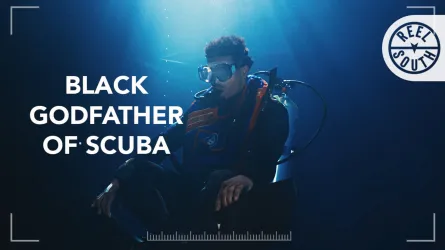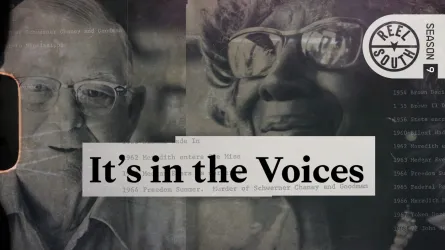Henrietta Boggs' life motto is "no matter what the obstacle, no matter how difficult your circumstances, just keep moving forward one step at a time, and you can still make a difference and create the life you desire," according to First Lady of the Revolution filmmaker Andrea Kalin. Kalin captures Boggs' life as a reluctant Southern belle from Alabama becoming the first lady of Costa Rica in the 1940s when her new husband is elected president. First Lady of the Revolution portrays a courageous woman who escaped the confines of a sheltered existence to help nurture a young democracy. Before the Reel South re-premiere of the film, we connected with Kalin to get insight into the creation of the film and her interactions with the now 102-year-old.
The interview has been edited for clarity.
What inspired you to make your film?
First Lady of the Revolution is a rare breed of epic. It recalls hemisphere-rocking events—protests, exile, revolution, war, and societal change—all narrated through the refreshing and atypical point of view of a young woman.
When I first met Henrietta Boggs in December of 2009, she quickly captivated me with her lingual dexterity, boundless energy, and indomitable spirit. Beyond being amused by her humor and wit, I became fascinated with her life’s journey and her improbable marriage to José Figueres, Costa Rica’s little giant, and the dramatic events that would sweep him into the presidency and Boggs into the role of the country’s Primera Dama, or First Lady. As First Lady, Henrietta championed reforms in education and women’s rights. Her persuasive ways not only helped grant women the right to vote but also opened key government positions to women for the first time.
First Lady of the Revolution is Henrietta’s remarkable story, untold on film until now. It is a deeply personal narrative featuring a daring American woman born in Alabama in 1918, who escapes the confines of a traditional, sheltered existence to expand her horizons into a new world and live a life she never imagined.
How did you get connected to your subject?
This story truly came to us through serendipity. I used to produce and direct all the multimedia for the Inter-American Development Bank’s annual meetings. In that role, I worked closely with Muni Figueres, who at the time was the IDB’s Director of External Relations. After leaving the Bank, Muni was appointed Costa Rican ambassador to the United States. One evening, I attended a holiday party at Muni’s house and was immediately drawn to an elegant, older woman seated in the corner, weaving stories before an enraptured audience. That woman was Muni’s mother, Henrietta—then 93 years old. I listened to her speak for all of five minutes before I knew her story had to be my next film—not only because of her past accomplishments but also because her passion for making the world a better place continued to burn even brighter now.
Were there any parts you wish you could have included in the film? If so, what were they?
First Lady of the Revolution is a sweeping story, featuring international events that still positively impact Costa Rica today, but it is also an intimate story that needed to stay close to Henrietta in order to maintain its point of view and emotional center. Achieving that balance, and doing so in one hour of screen time, was certainly a huge challenge.
I would have loved to delve more deeply into her experiences after she left Costa Rica. At one point, she worked for the Costa Rican mission at the United Nations. She lived in Paris for many years before re-connecting by letter with an old friend from school, Dr. Hugh MacGuire, a progressive doctor whose ideas on race and equality mirrored her own. After returning to Alabama, she was involved in the Montgomery Bus Boycott, driving African-American protestors to their jobs so they could still get to work without using the segregated public transportation system. Henrietta’s full life was (and still is—she’s 102!) fascinating and worthy of a longer treatment…maybe a sequel!
Were there parts with very interesting backstories that weren't totally relayed in the final film? Or what was your favorite behind-the-scenes moment?
Producing a film over a number of years, across borders and two countries was another fierce challenge. Yet despite these challenges, I feel so thankful and privileged to have had the opportunity to work with a diverse, multinational crew. In the spirit of the marriage of Henrietta and Don Pepe, and the cross-cultural exchange of ideas that came from it, we assembled a talented production team of Americans and Costa Ricans who were passionate about working on this film and committed to the task of restoring a page from history. That collaboration was at the heart of all my favorite behind-the-scenes moments.
I will always remember working on the music mix and audio design with our Costa Rican audio engineers Carlos and Daniel. The music for the scene taking place in the port city of Límon was not quite right because, while it sounded Central American, it was not authentically Costa Rican. This challenge was met head-on by the audio team; instead of searching for a new source cue, Carlos picked up his guitar and composed a beautiful melody on the spot, playing it to picture. The cue, called “Límon” on the film’s soundtrack, is not only Costa Rican but is indicative of the type of music you would hear in that city specifically. This is just one example of how we all learned so much from the multiple perspectives, varying frames of reference, and cultural diversity that were brought to the project. The film is certainly enriched, stronger, and more resonant because of the collaborative effort behind it.
What do you hope people learn/hope they take away from your film?
We hope Henrietta's story sparks conversations that are ripe with actionable takeaways about what each of us can do to fight inequality wherever it’s found. We hope First Lady of the Revolution inspires continued reflection and remembrance of the many women past and present whose voices have gone unheard, and who are still hindered on the path to reaching their full potential.
Hers is also a story that breaks down stereotypes on aging and proves that living a life of purpose is not limited to one’s youth.
Today, at over 102 years young, Henrietta is visually compelling and still deeply engaged with the world: presenting on a TEDx stage for thousands, crafting articles for the magazine River Region Living, acting as a member on several non-profit boards and as a docent at the local museum, and regularly entertaining an eclectic mix of artists and literary talents at her home, nurturing a culture of citizenship one revolution at a time.
First Lady of the Revolution also touches on so many disciplines (history, civics, women's studies, language studies) that it is tailor-made for use in the classroom. It has already been screened for thousands of students in Costa Rica and was selected to be part of the SUPER Teacher Program sponsored by the Alabama Humanities Foundation, and we hope other educators will also incorporate the film and resource materials into their lesson plans.
Is there anything else you'd like to share with the Reel South audience?
Ultimately, this story is about the struggle for a basic human right: self-determination. And I think we all know there’s much work to do at home and around the globe to ensure fundamental freedoms that make the world a more inclusive place. Henrietta inspires me to stand up, make my voice heard and to keep fighting for a more equitable society.
Her journey left an indelible mark on me, and her mantra in life I have adopted as my own: no matter what the obstacle, no matter how difficult your circumstances, just keep moving forward one step at a time, and you can still make a difference and create the life you desire. I think her message of perseverance, of learning to adapt when things go awry, of taking matters into one’s own hands is an apt lesson for independent filmmakers who often deal with a myriad of difficulties in trying to tell their stories. Encouraged by Henrietta’s example, I hope to stay focused, fierce, and continue to tell stories that put others in motion.
What advice would you give other filmmakers or others interested in documentary film?
I have always loved this adage: documentary filmmakers need talent, discipline and luck. You can only control one.
Can you complete this sentence: "What defines you..."
What defines me is the ability to find ways to turn challenges into opportunities. I have a persistent stubbornness that compels me to lift my head up see the rainbow on the horizon, and find the path that gets me there no matter how steep and rocky.
Category
Share


